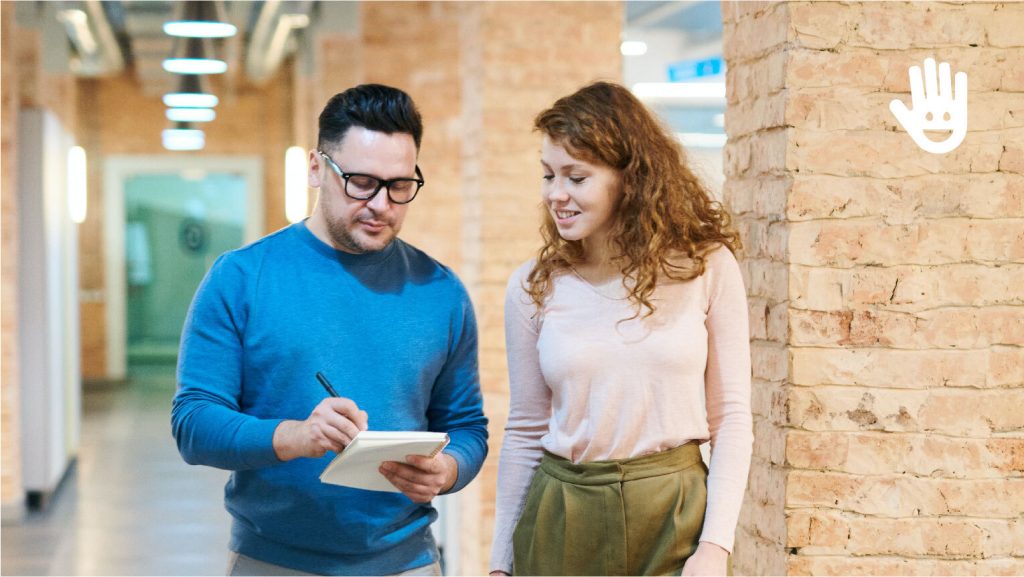HR expert Tim Sackett on Employee Engagement
2022-11-01
Tim Sackett on employee engagement, covering topics that go from leadership and motivation to millennials and public recognition.
We interviewed Tim Sackett on various hot trendy subjects within the employee engagement world. This interview covers topics that go from leadership and motivation to millennials and public recognition. Keep reading to find all his secrets!
Tim Sackett is a 20 year HR/Recruiting Talent Pro with a Master’s in HR and SPHR certification. He’s currently the President at HRU Technical Resources – a $40M IT and Engineering contract staffing firm and RPO. «As an HR/Talent Pro I really believe the most important thing an organization can do is increase its core talent base.»
Here is the interview he kindly took the time to answer for Tap My Back:
TMB: Do you remember when you started to get passionate about employee engagement and leadership? Was there a defining moment?
Tim: I was about three years into my HR career and had a great mentor. I was in a position where I was traveling a lot, regional HR role, and having to open and close retail locations. The openings were great. The closings were a nightmare. Employee engagement, culture and leadership were a daily struggle in a fast moving environment like this. I was naive enough to believe I could change the culture.
My mentor, the head of HR at this organization, said to me, “Tim, culture will always win.” That was my defining moment. Whatever culture you have, you have. You can replace leaders, you can paint the offices a different culture, you can hire and fire, but your culture will remain. Once you realize this, you begin to think about engagement and leadership differently. I’m passionate that leadership can influence culture, but that is just one small piece of the overall puzzle in creating and changing culture in your organization.
TMB: Some people say engagement is not that important as it treats employees only as mere tools for productivity and not as human beings. What do you have to say about that?
Tim: I think research has shown us that we can’t treat people like robots and expect long term productivity. Where this becomes complex is you can gain some short term productivity gains by treating employees less than human. This is confusing for some leaders who see the short term ‘fear’ gains, and think they can just keep pushing their employees like this. Fear is a great motivator for many (fear of losing your job, fear of not being able to pay your bills, etc.), and bad leaders use this to their advantage.
Eventually, the curve catches up and you see massive productivity slides by treating employees badly. I will say there is a fine line, that many organizations are struggling with right now. How do we treat our employees like they want to be treated, but also get the productivity out of these employees we need for the organization. Go to far in either direction and one side will pay. Give employees everything they want and the cost/benefit is usually too great for the organization. Do everything the organization wants, and the employees will rebel. The balance is key, but very hard to accomplish for most organizations.
TMB: What are the best ways to measure engagement inside a team or company?
Tim: I think there are many validated and reliable measures currently in play in the industry to measure engagement. Science has proven they can reliably measure employee engagement. The key is getting your executives and frontline managers to believe and understand what the data is actually saying, then give them a roadmap to make the right turns moving forward. What you normally see in most organizations when it comes to measuring employee engagement is they either do nothing with the data (worse case), or do too many things in trying to over-correct to fix the engagement problem (next worse case).
I think the best way to measure engagement is to understand what does success look like in your organization. Do you really know how to measure success? If you are being successful and have tow turnover (as compared to your industry), I would say your engagement is fine. Can it be better? Maybe, but is that really your biggest worry? Or, should we focus on something else? We get caught up in measuring engagement and this rush to raise engagement. We create an issue where it might not really be there.
TMB: A study says that 64% of all employees who quit their jobs didn’t feel recognized for their work. Should we worry?
Tim: All the new data coming out on feedback is concerning. We spent the better part of two decades tell our leadership and frontline managers that all you need to do is give your employees more feedback, constant feedback, feedback all the time! We teach our leaders how to give feedback. We design new feedback loops and technology around delivering feedback. Oh, wait, guess what? Our employees don’t want 'more’ feedback, they just want more attention. What!? Yeah, turns out, employees don’t like constructive feedback. They don’t like their boss sitting there telling them how to get better.
What they do like is their boss telling them what a rock star they are! Don’t we all. The leadership 'industry’ created a problem that is going to be very hard for us to turn the tide on. We’ve conditioned two generations of leaders to believe the best leaders give constant feedback, and now we have to tell them, stop that. Don’t give feedback like you’ve been trained to give feedback. People don’t like to be told what they suck at, they only want to hear about what they’re great at.
TMB: Can you give me five simple ideas any leader of any company can use to can motivate his/her staff?
Tim: 1. Heap positive praise upon them, constantly. 2. Stop focusing on what they don’t do well, and put them in situations that allow them to leverage their strengths. 3. Don’t treat all employees equally. High performers hate this. Plus, everyone wants to be treated as individuals. 4. Measure success, don’t measure hours. Most orgs measure hours because they really don’t know what success looks like by position. 5. Get to know your employees on a personal level.
TMB: Traditional annual performance reviews vs continuous feedback? Who wins your heart?
Tim: Neither! Both are flawed. The fact is organizations need the ability to measure performance and let employees know where they stand. Once per year is ridiculous in this attempt. I think a format of frequent check-ins with employees on how you as a leader can support them in being more successful is better. Along with using these check-ins as an alignment activity of making sure both sides are on the same page with priorities, expectations, etc.
TMB: Millennials, do they have a great impact on how managers see employee engagement?
Tim: I’m not using the word “millennials” anymore! I’m sick of it! Younger employees always will have an impact on how leaders lead. So, will mid-career pros, senior employees, etc. Millennials are no different than every other younger generation entering the workforce. Each generation comes in with new ideas, new energy, new beliefs on how work should be in their eyes. Leaders adapt to the workforce they have, and the work that needs to get done.
TMB: Is public recognition really so much better than money when it comes to staff motivation? And in the long run?
Tim: No. Public recognition is great, but only if compensation is none issue. You can’t trail the market in compensation and think that heaping public recognition on your employees is really going to make a difference. It won’t. Now, if compensation isn’t an issue, public recognition is great, for some employees. Some employees will take your public recognition as a punishment, because they’re introverts and don’t want it. Again, we get back to not treating all employees the same, and tailoring the recognition to fit the individual.
TMB: If I ask you what’s the worst approach to motivating and rewarding employees you’ve ever heard or seen (even if the intentions were good), what’s the first thing that pops into your mind?
Tim: I think anytime you put employees in a situation where one wins and one loses, in an attempt to motivate, you will eventually have problems. This is what most sales functions do, right? So, it can’t be all bad. But, then you look at engagement and turnover, and you realize why sales organizations struggle so hard to find talent. They de-motivate by design. They only want the people who want to 'win’ those contests, and are willing to put up with the 'losers’ leaving. I think this is a bad approach overall.
TMB: In your opinion, what are the three big trends in employee engagement for the next 5 years?
Tim: 1. Organizations doing a better job hiring for the talent that 'fits’ their organization, which will in turn create higher engagement, organically. 2. Data analytics driving better decisions in how to move the engagement needle at the department and organization level. 3. More dynamic leadership development, focused on the frontline leader level who have the most direct impact to employee engagement.
Our many thanks to Tim for his time and awesome insights. You can find him here: http://www.timsackett.com/ @timsackett
See More Posts
Platform
Features
Tap My Back @2025. All rights reserved.




